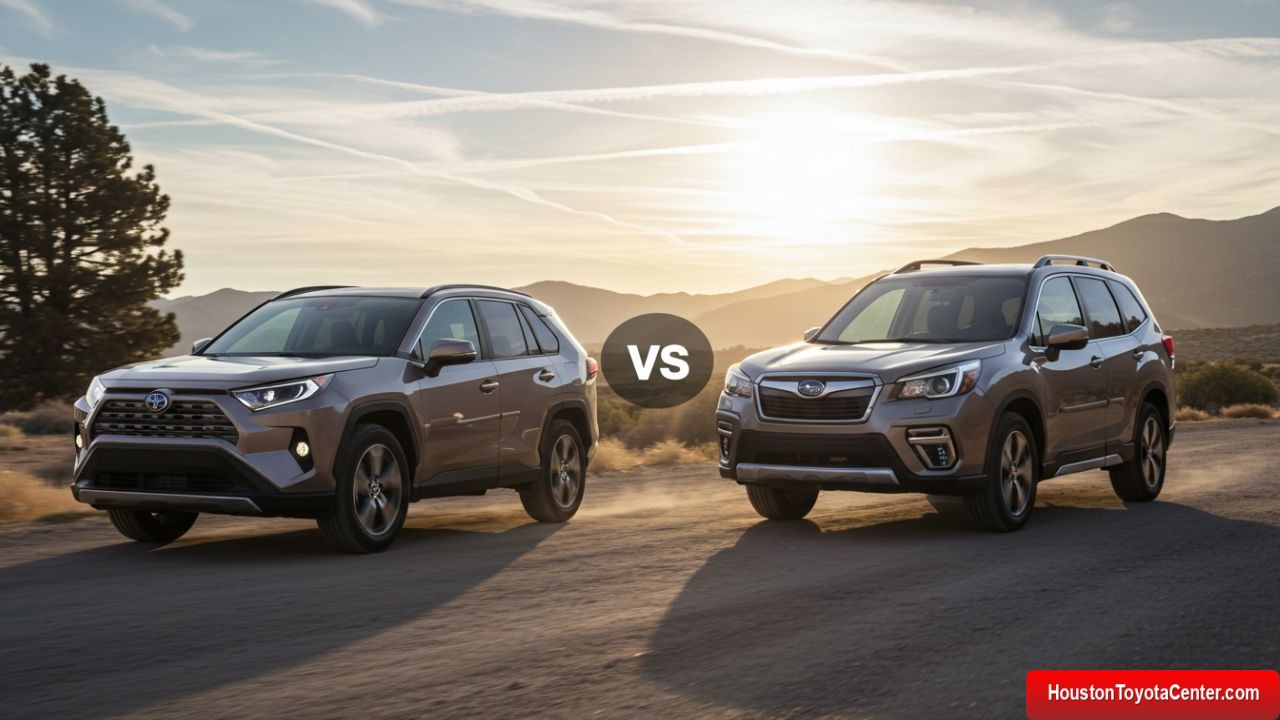The compact SUV segment is one of the most competitive in the automotive industry, with manufacturers constantly vying for the top spot. Two of the most popular and highly regarded models in this category are the Toyota RAV4 and the Subaru Forester. Both vehicles have earned their reputations for reliability, versatility, and value, but they cater to slightly different audiences. In this comprehensive comparison, we’ll dive deep into the features, performance, design, and overall value of the Toyota RAV4 and Subaru Forester to help you decide which one is the better choice for your needs.
1. Introduction to the Compact SUV Segment
Compact SUVs have become the go-to choice for many buyers due to their blend of practicality, comfort, and affordability. They offer the space and versatility of larger SUVs without the hefty price tag or fuel consumption. The Toyota RAV4 and Subaru Forester are two of the most established names in this segment, each with a loyal fan base and a history of delivering dependable vehicles.
The RAV4, first introduced in 1994, is one of the pioneers of the compact SUV segment. It has consistently been one of the best-selling vehicles in the United States, thanks to its reputation for reliability, fuel efficiency, and family-friendly features. The Forester, on the other hand, has carved out a niche for itself as a rugged, adventure-ready SUV with standard all-wheel drive and a focus on safety.
2. Exterior Design and Styling
Toyota RAV4
The Toyota RAV4 has undergone a significant transformation in recent years, adopting a more aggressive and modern design. The current generation features sharp lines, a bold front grille, and a muscular stance that gives it a more rugged appearance compared to its predecessors. The RAV4 is available in several trims, including the adventure-focused TRD Off-Road and the fuel-efficient Hybrid model.
FREE: Quickly identify and understand problems with your vehicle 🚘
CLICK HEREThe RAV4’s design is both stylish and functional, with features like available LED headlights, roof rails, and a power liftgate. Its overall aesthetic appeals to a wide range of buyers, from young families to outdoor enthusiasts.
Subaru Forester
The Subaru Forester, in contrast, has a more understated and practical design. It retains its boxy shape, which maximizes interior space and visibility. The Forester’s design is less flashy than the RAV4’s, but it has a timeless appeal that resonates with buyers who prioritize functionality over flair.
The Forester also offers features like standard roof rails, LED headlights, and available fog lights. While it may not turn heads like the RAV4, its design is well-suited for those who value simplicity and utility.
Verdict: The RAV4 wins in terms of bold styling and modern aesthetics, while the Forester appeals to those who prefer a more traditional and functional design.
3. Interior Comfort and Space
Toyota RAV4
The RAV4’s interior is designed with comfort and convenience in mind. The cabin features high-quality materials, a user-friendly layout, and plenty of tech features. The seats are comfortable and supportive, making it a great choice for long drives. The RAV4 offers 37.6 cubic feet of cargo space behind the rear seats, which expands to 69.8 cubic feet with the seats folded down.
The RAV4’s infotainment system includes a standard 7-inch touchscreen, with an available 8-inch display on higher trims. Apple CarPlay, Android Auto, and Amazon Alexa compatibility are standard, along with a Wi-Fi hotspot. Higher trims add premium features like a JBL audio system, heated and ventilated front seats, and a panoramic sunroof.
Subaru Forester
The Forester’s interior is spacious and practical, with a focus on durability and functionality. The cabin is well-built, with soft-touch materials and a clean, straightforward layout. The Forester offers 31.1 cubic feet of cargo space behind the rear seats, which expands to 76.1 cubic feet with the seats folded down. While it has slightly less cargo space than the RAV4, the Forester’s boxy design makes it easier to load larger items.
The Forester comes standard with a 6.5-inch touchscreen, with an available 8-inch display on higher trims. Apple CarPlay and Android Auto are standard, but the system lacks some of the polish and responsiveness of the RAV4’s setup. Higher trims add features like a Harman Kardon audio system, heated front and rear seats, and a power liftgate.
Verdict: The RAV4 offers a more upscale and tech-savvy interior, while the Forester provides a more practical and durable cabin with slightly better cargo versatility.
4. Performance and Fuel Efficiency
Toyota RAV4
The RAV4 is available with two powertrain options: a standard 2.5-liter four-cylinder engine and a hybrid variant. The gas-powered engine produces 203 horsepower and 184 lb-ft of torque, paired with an eight-speed automatic transmission. Front-wheel drive is standard, with all-wheel drive available on most trims.
The RAV4 Hybrid combines a 2.5-liter four-cylinder engine with electric motors to produce 219 horsepower. It offers excellent fuel efficiency, with EPA estimates of 41 mpg in the city and 38 mpg on the highway. The hybrid model also comes standard with all-wheel drive.
Subaru Forester
The Forester is powered by a 2.5-liter four-cylinder engine that produces 182 horsepower and 176 lb-ft of torque. It’s paired with a continuously variable transmission (CVT) and comes standard with all-wheel drive. While the Forester’s engine is less powerful than the RAV4’s, it provides adequate performance for daily driving and light off-roading.
The Forester’s fuel efficiency is competitive, with EPA estimates of 26 mpg in the city and 33 mpg on the highway. However, it falls short of the RAV4 Hybrid’s impressive numbers.
Verdict: The RAV4 offers better performance and fuel efficiency, especially in its hybrid form, while the Forester’s standard all-wheel drive makes it a strong contender for those who prioritize traction and stability.
5. Safety Features
Toyota RAV4
The RAV4 comes standard with Toyota Safety Sense 2.0, a suite of advanced driver-assistance features that includes:
- Adaptive cruise control
- Lane departure warning with steering assist
- Automatic emergency braking with pedestrian detection
- Automatic high beams
Higher trims add features like blind-spot monitoring, rear cross-traffic alert, and a surround-view camera system.
Subaru Forester
The Forester comes standard with Subaru’s EyeSight Driver Assist Technology, which includes:
- Adaptive cruise control
- Lane departure warning
- Pre-collision braking
- Lead vehicle start alert
The Forester also offers additional safety features like blind-spot detection, rear cross-traffic alert, and reverse automatic braking.
Verdict: Both vehicles offer comprehensive safety features, but the Forester’s standard all-wheel drive and slightly more advanced safety tech give it a slight edge.
6. Off-Road Capability
Toyota RAV4
The RAV4 is available in an Adventure trim and a TRD Off-Road trim, both of which are designed for light off-roading. These trims feature upgraded suspension, all-terrain tires, and additional underbody protection. The RAV4 Hybrid also offers impressive traction thanks to its electric all-wheel drive system.
Subaru Forester
The Forester is known for its off-road prowess, thanks to its standard all-wheel drive and generous ground clearance. While it lacks dedicated off-road trims, the Forester’s symmetrical all-wheel drive system and X-Mode for low-speed off-roading make it a capable choice for adventurous buyers.
Verdict: The Forester’s standard all-wheel drive and off-road features make it the better choice for serious off-roaders, while the RAV4’s Adventure and TRD trims cater to casual off-road enthusiasts.
7. Pricing and Value
Toyota RAV4
The RAV4 has a starting price of around 28,000forthebaseLEtrim,withhighertrimsrangingupto28,000forthebaseLEtrim,withhighertrimsrangingupto40,000. The RAV4 Hybrid starts at around 31,000andtopsoutat31,000andtopsoutat43,000 for the fully loaded Limited trim.
Subaru Forester
The Forester starts at around 27,000forthebasetrim,withhighertrimsrangingupto27,000forthebasetrim,withhighertrimsrangingupto38,000. While it’s slightly more affordable than the RAV4, it lacks a hybrid option, which could be a drawback for eco-conscious buyers.
Verdict: The Forester offers better value for budget-conscious buyers, while the RAV4’s hybrid option and premium features justify its higher price tag.
8. Conclusion
Both the Toyota RAV4 and Subaru Forester are excellent choices in the compact SUV segment, but they cater to slightly different audiences. The RAV4 is the better option for those who prioritize style, performance, and fuel efficiency, especially in its hybrid form. On the other hand, the Forester is ideal for buyers who value standard all-wheel drive, off-road capability, and a practical, no-nonsense design.
Ultimately, the choice between the RAV4 and Forester comes down to your specific needs and preferences. If you’re looking for a well-rounded, tech-savvy SUV with excellent fuel economy, the RAV4 is the way to go. But if you need a rugged, adventure-ready vehicle with standard all-wheel drive and a focus on safety, the Forester is the better choice.
This comparison highlights the strengths and weaknesses of both vehicles, helping you make an informed decision. Whether you choose the Toyota RAV4 or the Subaru Forester, you’re getting a reliable, versatile, and capable compact SUV that’s sure to meet your needs.


Leave a Reply